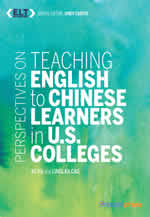Free TESOL Journal Article: "Vocabulary Knowledge and Vocabulary Use in Second Language Writing"
by Mark D. Johnson, Anthony Acevedo, and Leonardo Mercado
This article first appeared in TESOL Journal, Volume 7, Number 3, pgs. 700–715. Subscribers can access issues here. Only TESOL members may subscribe. To become a member of TESOL, please click here, and to purchase articles, please visit Wiley-Blackwell. © TESOL International Association.
|
Abstract
Research has consistently shown diversity of vocabulary to be an important indicator of second language (L2) writing development as well as L2 writing performance. These studies underscore the importance of vocabulary to L2 writing. However, they provide little to indicate what kind of vocabulary learners of English may need to know in order to develop writing proficiency. This small-scale pilot study examined the relationships among vocabulary knowledge, vocabulary use, and L2 writing performance. The results suggest that accurate productive knowledge of high-frequency word families was associated with L2 writing performance. However, actual use of high-frequency word families was negatively associated with L2 writing performance. Based on the results, the authors present potential uses of lexical frequency information to help students develop (a) accurate productive knowledge of high-frequency word families and (b) a repertoire of low-frequency word families based on their communicative needs. |
To say that vocabulary is important to writing seems obvious. However, to the practicing teacher of second language (L2) writing, vocabulary takes on added importance because L2 writers often struggle with limited vocabulary or with vocabulary that may have been only partially learned (Nation, 2001). Despite the importance of vocabulary to L2 writing performance, L2 writing researchers have offered little to inform L2 writing instructors' practice aside from the consistent finding that a greater diversity of vocabulary is associated with stronger L2 writing performance (Engber, 1995; Grant & Ginther, 2000). However, research is slowly beginning to inform the selection of target vocabulary for instruction and the types of knowledge that need to be developed to improve L2 writers' performance.
Originally designed to examine the size and development of L2 writers' productive vocabularies, early research used lexical frequency profiles to compare the vocabulary in L2 writers' texts to word frequency lists, typically the first (1K) and second (2K) 1,000 most frequent word families according to the General Services List (GSL; West, 1953) in combination with either (a) the University Word List (UWL; Xue & Nation, 1984) or (b) the Academic Word List (AWL; Coxhead, 2000). Vocabulary that did not appear in any of these lists was simply described as “beyond” the 2K frequency band.
The handful of studies using lexical frequency profiles to analyze L2 writers' texts have found that the use of vocabulary that appears less frequently in the English language—usually measured as decreased use of words from the 1K and 2K GSL list and increased use of words from the AWL or UWL and from beyond the 2K GSL list—is associated with L2 writing development over time as well as L2 writing performance (Laufer, 1994; Laufer & Nation, 1995). More recent studies using frequency lists based on the Bank of English corpus (Coniam, 1999), British National Corpus (Johnson, Acevedo, & Mercado, 2013), or specialty frequency lists generated from the participants' own writing (Verspoor, Schmid, & Xu, 2012) appear to support the findings of earlier studies using the GSL and UWL or AWL. To summarize the findings of these studies concisely, the use of words that appear less frequently in the English language is associated with stronger L2 writing performance as well as L2 writing development over time. Missing from research on vocabulary and its role in L2 writing performance is an exploration of vocabulary knowledge and its relationship to vocabulary use. In order to better understand this relationship, the following small-scale pilot study was driven by the following research questions:
-
What are the relationships among receptive, productive, and aural vocabulary knowledge and L2 writing performance?
-
What are the relationships among vocabulary use and L2 writing performance?
-
How do stronger and weaker L2 writers differ in receptive/productive/aural vocabulary knowledge?
-
How do stronger and weaker L2 writers differ in their use of vocabulary?
This article first appeared in TESOL Journal, 7, 700–715. For permission to use text from this article, please go to Wiley-Blackwell and click on "Request Permissions" under "Article Tools."
doi: 10.1002/tesj.238
TESOL Blogs
Interested in writing a blog for TESOL?
Read the submission guidelines and send us your post!
Check out a few recent TESOL Blog posts:
|
TESOL President’s Blog: SETESOL Conference, by Ester De Jong
 One partnership that TESOL has with its 100+ affiliates is the Affiliate Speaker Program. This program encourages TESOL’s affiliate partners to select a TESOL board member to come and speak at their conference. As part of this program, I had the pleasure of visiting Argentina when I was on the board of directors. Luciana de Oliveira, our current president-elect, wrote a wonderful reflection on how powerful these experiences are for both the affiliate and the board member. Read more. One partnership that TESOL has with its 100+ affiliates is the Affiliate Speaker Program. This program encourages TESOL’s affiliate partners to select a TESOL board member to come and speak at their conference. As part of this program, I had the pleasure of visiting Argentina when I was on the board of directors. Luciana de Oliveira, our current president-elect, wrote a wonderful reflection on how powerful these experiences are for both the affiliate and the board member. Read more.
|
|
Challenging Leadership Stereotypes Through Discourse, by Kevin Knight
 Have you considered how the ESP Project Leader Profiles (36 published to date with projects on six continents) might be viewed as research data that can give us a deeper understanding of leadership itself? Please keep this question in mind as I share with you in this TESOL Blog post a new book that explores leadership using discourse analytical approaches. Read more. Have you considered how the ESP Project Leader Profiles (36 published to date with projects on six continents) might be viewed as research data that can give us a deeper understanding of leadership itself? Please keep this question in mind as I share with you in this TESOL Blog post a new book that explores leadership using discourse analytical approaches. Read more.
|
|
The Betty Azar Travel Grants: Gobinda Puri at TESOL 2017, by Sherry Blok
 Did you know Betty Azar generously supports TESOLers in their professional development annually? This year, we are very proud to have renamed the award the Betty Azar Travel Grant for Practicing ESL ESL/EFL Teachers because she deserves that recognition. This is the second year I’m coordinating the award and I can attest that volunteering on the TESOL Awards Council is an excellent way to connect with Betty, but also the award recipients all the committed volunteer reviewers. One special recipient of the award is Gobinda Puri, an educator from Nepal. Betty’s generous donation helps educators like Gobinda make a difference with his learners and community. Please read on as Gobinda shares his experience from the 2017 TESOL International Convention and Expo in Seattle. Read more. Did you know Betty Azar generously supports TESOLers in their professional development annually? This year, we are very proud to have renamed the award the Betty Azar Travel Grant for Practicing ESL ESL/EFL Teachers because she deserves that recognition. This is the second year I’m coordinating the award and I can attest that volunteering on the TESOL Awards Council is an excellent way to connect with Betty, but also the award recipients all the committed volunteer reviewers. One special recipient of the award is Gobinda Puri, an educator from Nepal. Betty’s generous donation helps educators like Gobinda make a difference with his learners and community. Please read on as Gobinda shares his experience from the 2017 TESOL International Convention and Expo in Seattle. Read more.
|
TESOL Bookstore

Featured Resources from TESOL Press
 Teaching English to Chinese Learners in U.S. Colleges
Teaching English to Chinese Learners in U.S. Colleges
Ke Xu and Liglan Cao
Gain an in-depth understanding of the Chinese learner to improve your teaching practices and help your students succeed. Take a step back from familiar contexts and examine how institutional structures, the relationship between the U.S. and a student's country of origin, and the student's motivations and attitudes all play a role in their English learning.
 TESOL Voices: Adult Education
TESOL Voices: Adult Education
Tim Stewart, Editor
Follow the triumph and trials of real-life students as they learn English, whether they're pursuing it for their vocation, as immigrants to a new country, for travel, or for their very survival.
 More Than A Native Speaker: An Introduction to Teaching English Abroad, Third Edition
More Than A Native Speaker: An Introduction to Teaching English Abroad, Third Edition
Don Snow and Maxi-Ann Campbell
In this newly updated third edition, learn step-by-step how to effectively teach English abroad. Gain valuable tips and resources for teaching in an unfamiliar educational system, working with students of varying ages and skill levels, and adapting to life in a different culture. A rich array of online resources and activities included.